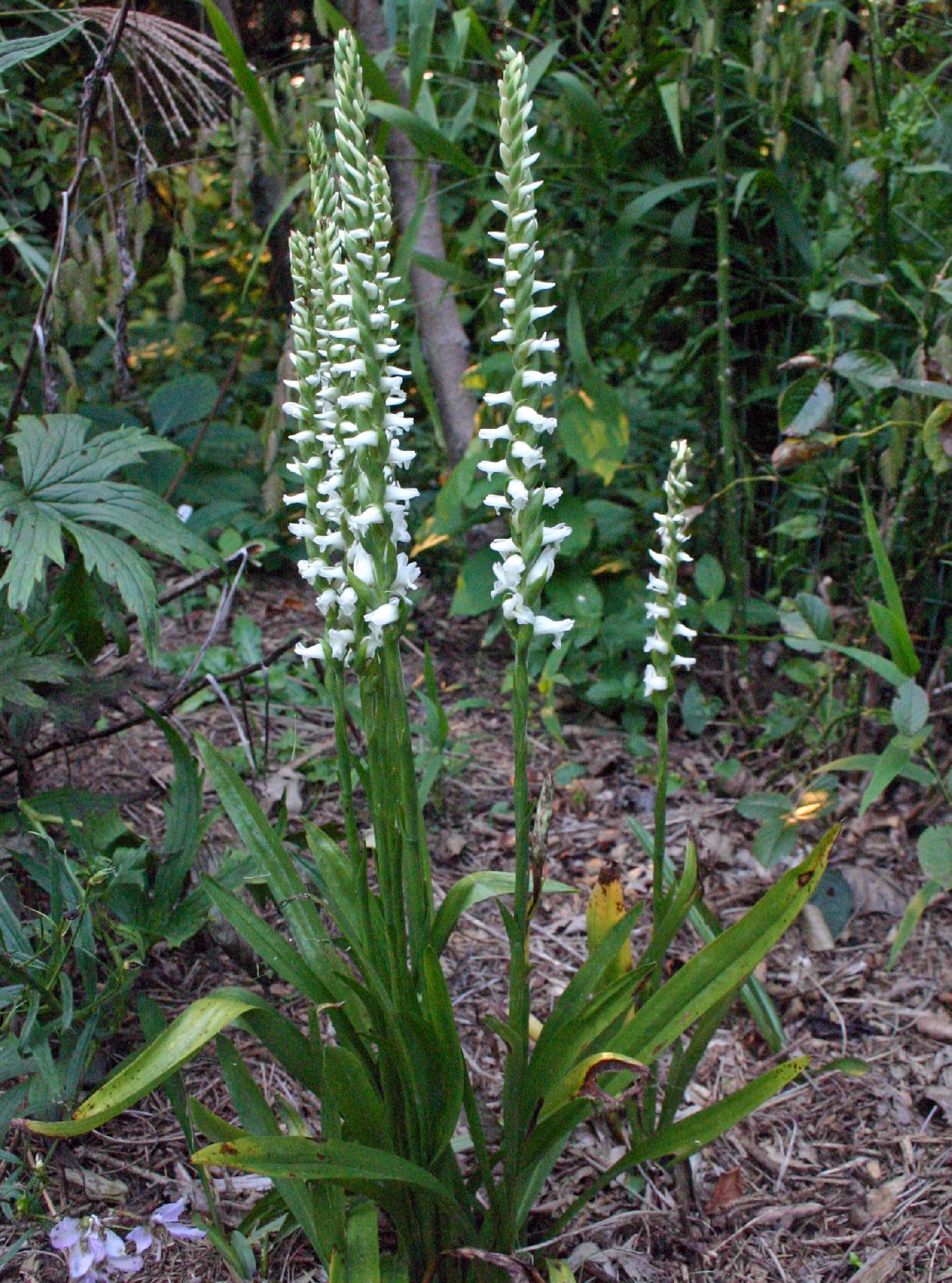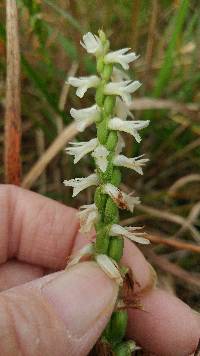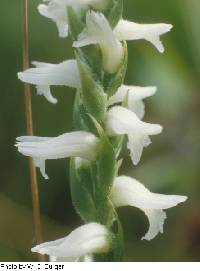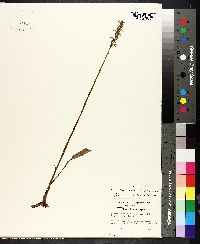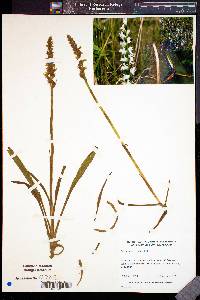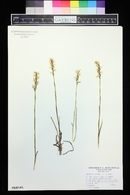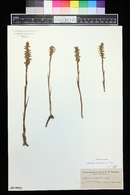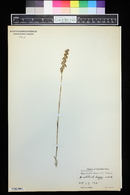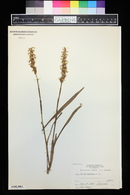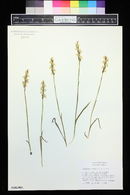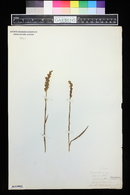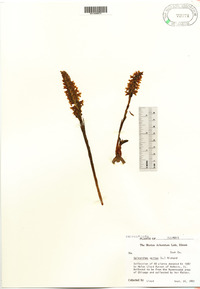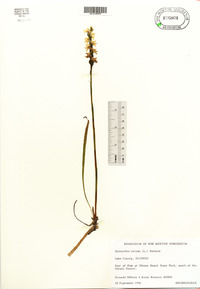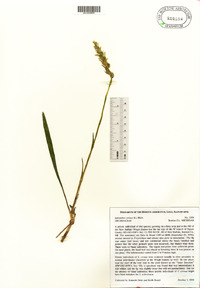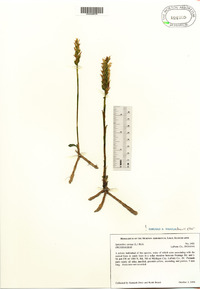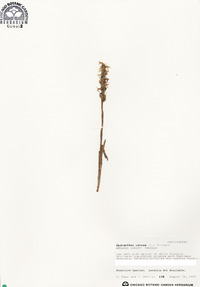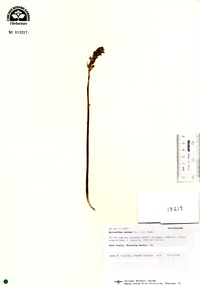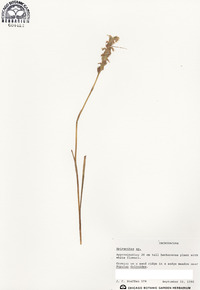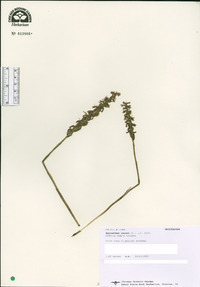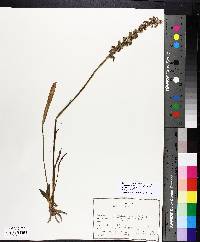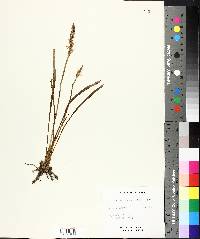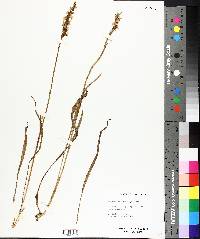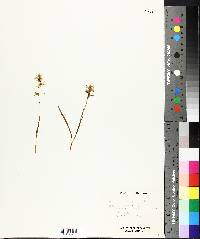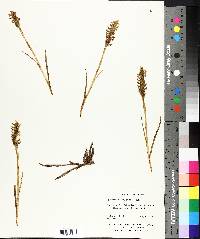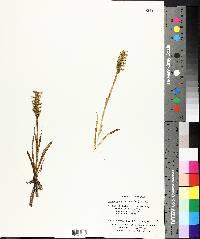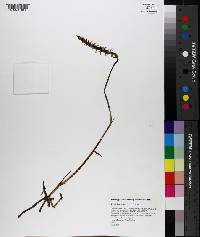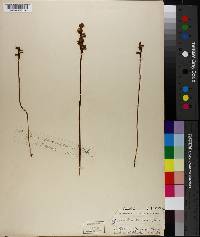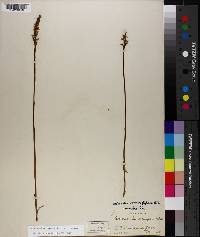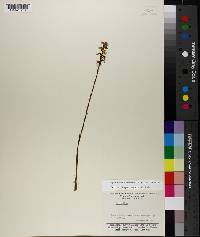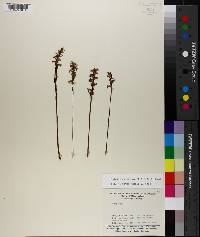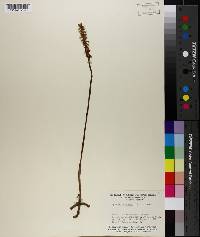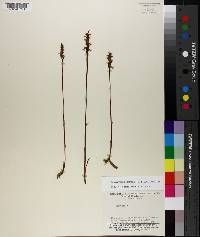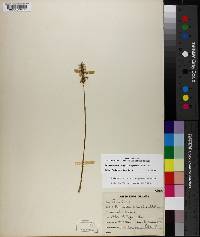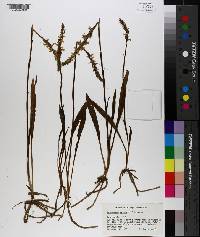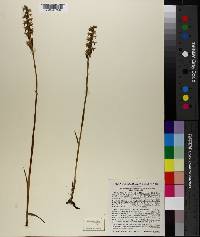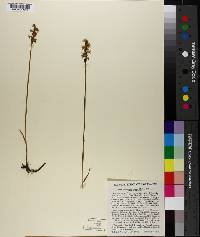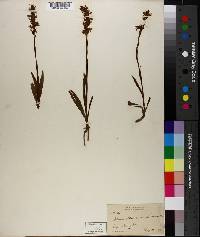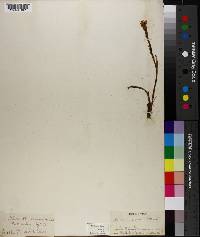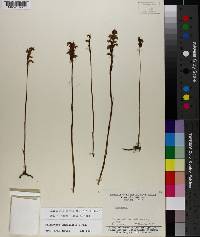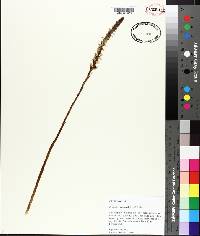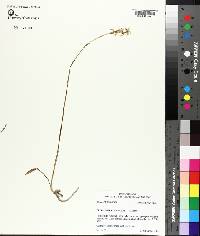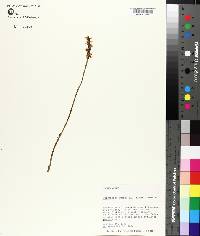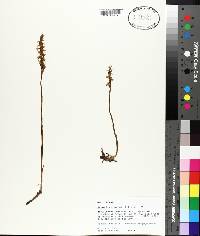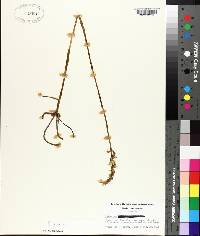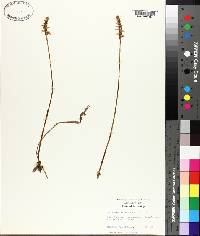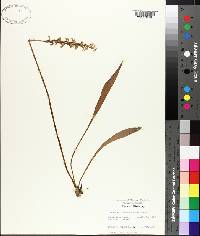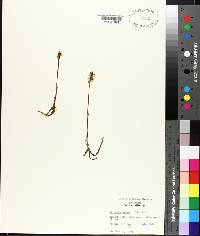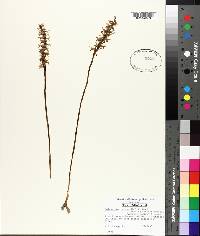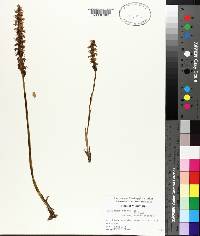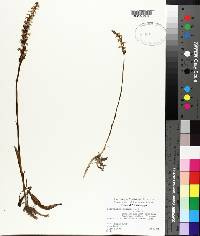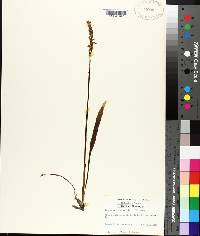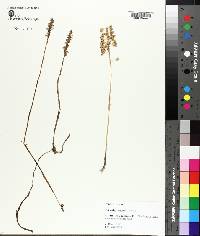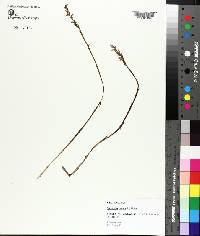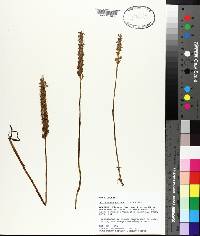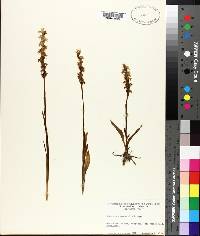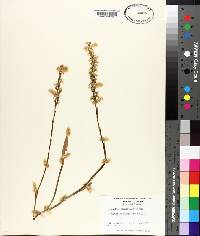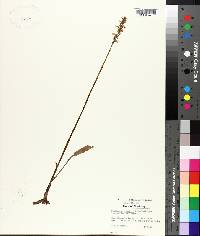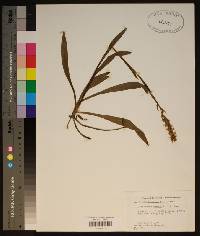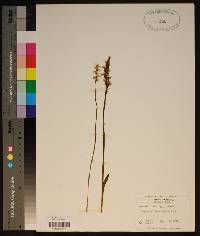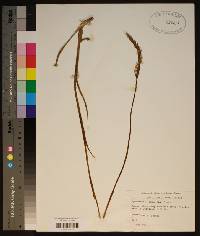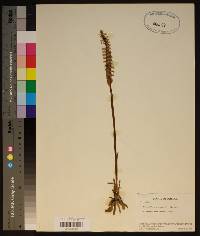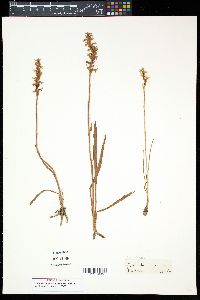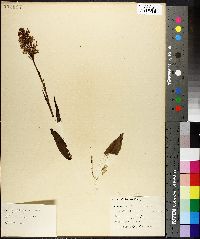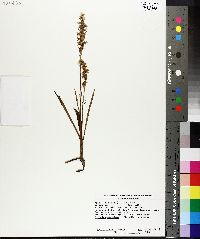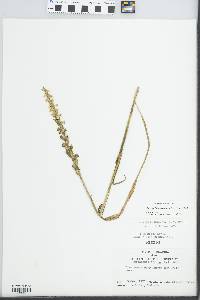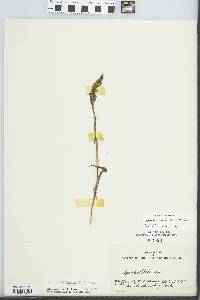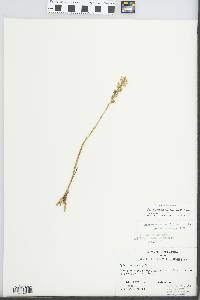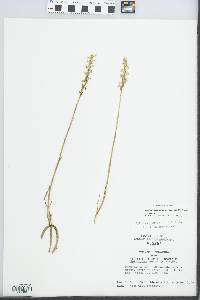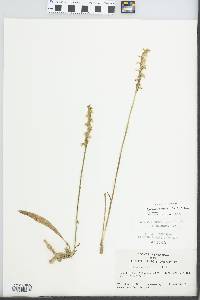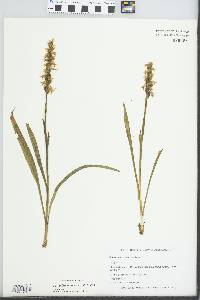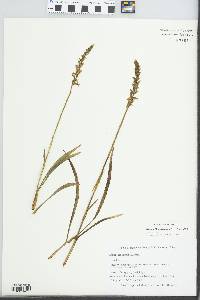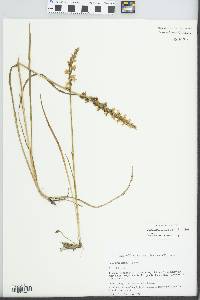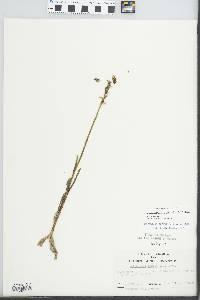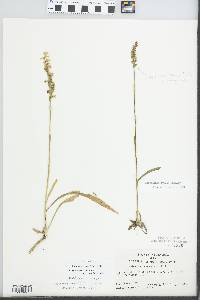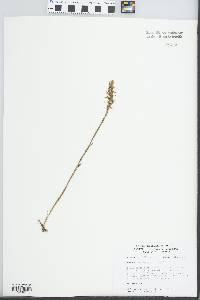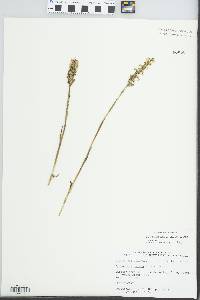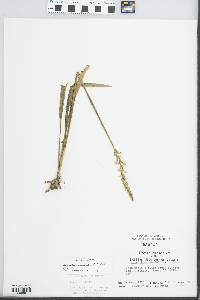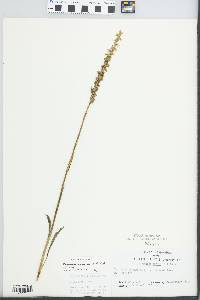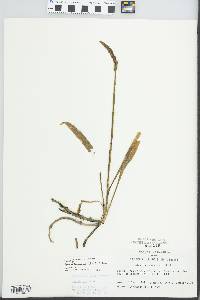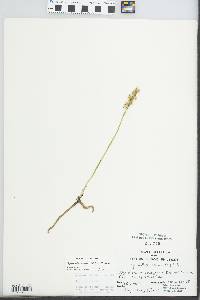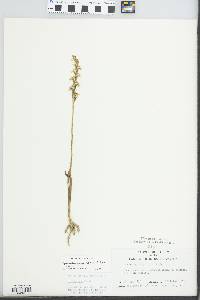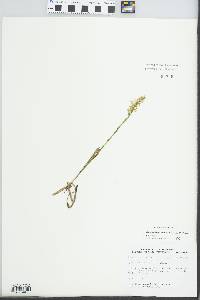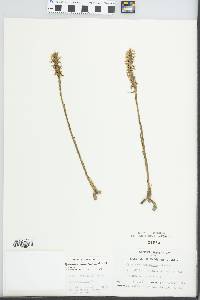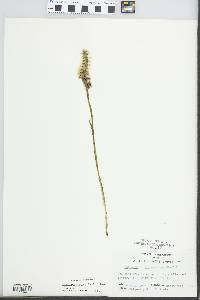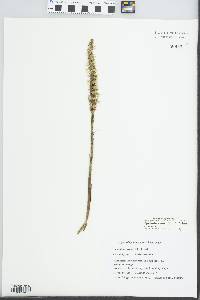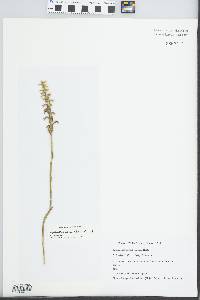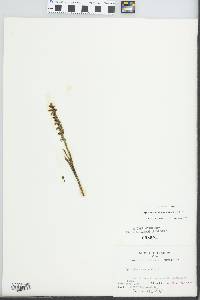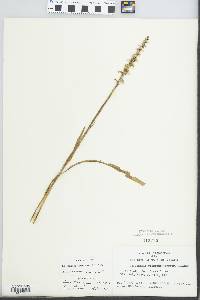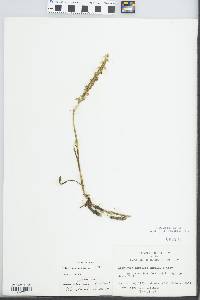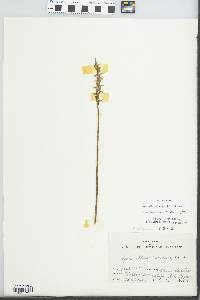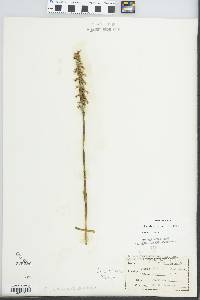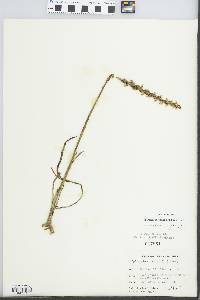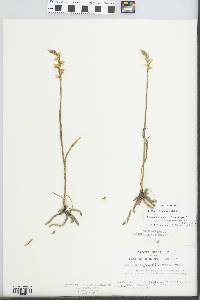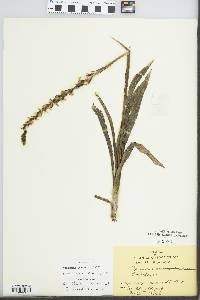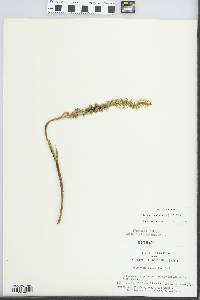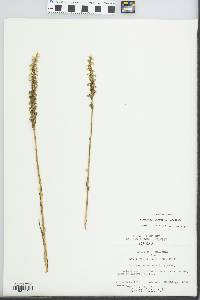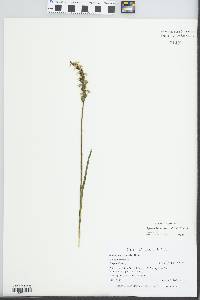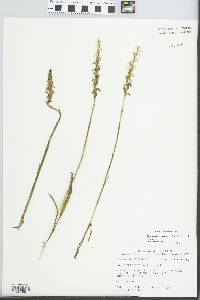Spiranthes cernua
|
|
|
|
Family: Orchidaceae
White Nodding Ladies'-Tresses, more...nodding lady's tresses
[Gyrostachys cernua, moreGyrostachys constricta , Ibidium incurvum Jenn.] |
Plants 10-50 cm. Roots few, slender to tuberously thickened, horizontally spreading to descending, mostly to 1 cm diam. Leaves persisting through anthesis or fugaceous, basal, sometimes on proximal portion of stem, ascending to spreading (flaccidly so because of membranaceous blades with thickened midribs); petiole usually slender, less than 6 mm wide; blade linear-lanceolate to linear-oblanceolate, oblanceolate, obovate, or elliptic, to 26 × 2 cm. Inflorescences: spikes very tightly to rather loosely spiraled, 3-4 flowers per cycle of spiral, rarely in loose spiral with 5 or more flowers per cycle; rachis moderately to densely pubescent, some trichomes capitate, glands obviously stalked. Flowers white to ochroleucous, creamy, or ivory, occasionally green or rarely yellowish, nodding only at base of perianth or occasionally ascending, urceolate to gaping, base usually appearing only slightly inflated, claw of lip at low (less than 30°) angle to lamina, or occasionally not opening; sepals distinct to base, 6-12 mm; lateral sepals appressed to spreading, apices incurved or sometimes straight, sometimes arching above flower; petals linear-lanceolate, 6-12 mm, apex acute to obtuse, occasionally broad and liplike; lip often yellow centrally, ovate to oblong in general outline, usually constricted at middle, 6-10.5 × 2-7.5 mm, base ± prominently dilated, suborbiculate, orbiculate, or linear, margins crenulate, lacerate or sometimes entire, apex acute to rounded distally, glabrous; veins several, branches parallel; basal calli usually incurved, prominent to conic, small, mostly 0.5-1.2 mm, or sometimes lip undifferentiated from petals; viscidia linear to linear-lanceolate; ovary 3-14 mm. Seeds polyembryonic, often also monoembryonic, rarely wholly monoembryonic; typically showing irregularities such as embryos developing through or outside testa or naked embryos mixed with whole seed. 2n = 45, 60. Flowering late Aug--Nov. Wet to dry open sites in fens, marshes, meadows, swales, dunes, prairies, open woodlands, riverbanks, shores, ditches, roadsides, old fields, cemeteries, lawns; 0--1800 m; N.B., N.S., Ont., P.E.I., Que.; Ala., Ark., Conn., Ga., Ill., Ind., Iowa, Kans., Ky., La., Maine, Md., Mass., Mich., Minn., Miss., Mo., Nebr., N.H., N.J., N.Y., N.C., Ohio, Okla., Pa., R.I., S.C., Tenn., Tex., Vt., Va., W.Va., Wis. Spiranthes cernua is a facultatively agamospermic polyploid compilospecies in which unidirectional gene flow from related diploids generates a wide range of novel forms and races. Chromosomal segregation has given rise to some forms that very nearly approximate the diploid donor, and meiotic irregularities produce peloria and other abnormal conditions. Apomixis then permits reproduction in pure lines, some of which are so distinctive as to appear to be species. Determination of this and related species is consequently often challenging. Adventitious embryony in this species commonly gives rise to polyembryonic seeds and seeds exhibiting irregularities such as embryos erupting through or developing outside the testa and naked embryos lacking testae. Often a capsule contains a mixture of polyembryonic and monoembryonic seeds. Rarely all or most seed is monoembryonic, yet irregularities can still be seen. Polyembryony is also characteristic of Spiranthes casei and S. parksii, species that are probably derivatives of S. cernua. For the most part, at least, related diploids and all other species are strictly sexual and characterized by wholly monoembryonic seed. Some indication of apomixis and polyembryony in S. magnicamporum, S. ochroleuca, and S. odorata in the northeastern portion of the range of the complex has been reported (P. M. Catling 1981, 1982), but the difficulty in distinguishing between diploid donors and tetraploid chromosomal segregates makes interpretation difficult (C. J. Sheviak 1982, 1991). In particular, the range of S. odorata northward along the Atlantic Coast is uncertain. Plants that appear typical of S. odorata in all respects but with polyembryonic seed occur from Virginia northward and quickly replace monoembryonic plants toward the north. Such plants from as far south as Virginia, however, have proven to be tetraploids and furthermore to assume morphology typical of S. cernua when grown away from the Coast. Gene flow from Spiranthes magnicamporum generates cytogenetically based peloria, a common element in portions of the prairie region. Most commonly differentiation of the lip is suppressed, but in some forms the petals are elaborated and approach the lip in form. Additionally, buds may fail to open and a functional column may be lacking, yet seed is produced apomictically. See the discussion under 16. S. parksii.
Perennial herb 10 - 50 cm tall Stem: single, erect, green, hairy (hairs round-tipped), usually only with leaf-like sheaths most of length. Leaves: three to five, mostly basal, ascending to spreading, narrowly short-stalked, hairless, non-toothed, 10 - 26 cm long, 0.5 - 2 cm wide, elliptic to narrowly lance-shaped or inversely lance- or egg-shaped, thin and membranous, but with thickened midrib. The leaves usually persist through flowering time, but some individuals may lose their leaves. Inflorescence: a single, erect, terminal, elongate spike of 24 to 40 somewhat nodding flowers. The flowers are arranged in a spiral with three to four flowers per full turn around the axis. Axis covered with stalked glandular hairs and sometimes also branched hairs. Flowers: white to ivory or clear creamy (occasionally green, rarely yellowish), usually partially nodding (at least at point just above ovary), bilaterally symmetric, about 8 - 11 mm long (above ovary), urn-shaped to open-gaping with slightly inflated base (but lacking spur), and drooping, broad-tipped lip. The reproductive parts of stamens, stigma and style are fused into a column above the 0.3 - 1.4 cm long inferior ovary (in shorter flowers ovary often much shorter than petals). Sepals: three, petal-like, white, 0.6 - 1.2 cm long, closely positioned with lateral petals, forward-pointing, appressed or slightly spreading at tips which may be straight or curved inward. Roots: few, horizontally spreading to descending, slender to tuberously thickened (at most 1 cm diameter). Lateral petals: two, forward-pointing, closely positioned to sepals above lip, white, 0.6 - 1.2 cm long, linear-lance-shaped with pointed or rounded tips, occasionally broad and lip-like. Lip petal: one, central, lowermost, forward-pointing with downward curved tip, white (often yellow down center), hairless, typically wavy-edged (or deeply cut), membranous or fleshy, 0.6 - 1 cm long, 2 - 7.5 mm wide, egg-shaped to oblong in outline with pointed or rounded tip, narrowed middle section, and widened, almost round base. There are several parallel-branching veins along the lip, and also two, small (0.5 - 1.2 mm tall), incurved, basal projections (calli), which are often cone-shaped. Similar species: Spiranthes cernua is most similar to S. ochroleuca, but the flowers of that species are more dull yellowish white to cream-colored, and held more upright against the inflorescence stalk. Also incredibly similar is S. magnicamporum, but it usually has no leaves at flowering time, the flowers always have a strong almond- or vanilla-like odor, and the lateral sepals spread upwards with inward curved tips. Flowering: August through October Habitat and ecology: Locally frequent in moist, often calcareous meadows and pannes, but also in moist acid sandy areas. Occurence in the Chicago region: native Notes: This is our most common species of Spiranthes, but it is quite variable in morphology. Sometimes the flowers are barely nodding, and other times the lip petal may not be much different in shape or arrangement from the lateral petals. On many plants the buds will not open, yet seed will be produced. The seeds of S. cernua commonly have more than one embryo per seed (polyembryony), and it is rare that all of the seeds in a capsule will have only one embryo per seed (Sheviak and Brown 2002). This characteristic is also seen in S. casei and S. parksii. Those species are probably derived from S. cernua. Author: The Field Museum Plants 1-4(-8) dm; basal lvs narrow, to 30 cm, 5-50 mm wide; cauline sheaths 3-8, sometimes with a spreading-recurved blade; infl 2-18 cm, with shortly glandular- hairy axis, dense, the fls ±in 3 or 4 vertical ranks, 8-11(-15) mm, individually widely spreading or somewhat declined, urceolate-cylindric, only the upper sep and lateral pet connivent, the lateral sep looser but scarcely spreading; lip moderately to sometimes (var. ochroleuca) strongly arcuate-recurved, ovate or ovate-oblong or obcuneate, often dilated and cordate at base, erose or crisped around the broad summit, somewhat yellowish- green in the center, the fls otherwise white or whitish (or more ochroleucous in var. ochroleuca); callosities at base of lip often 1 mm or more, higher than thick; viscidium 1-2 mm, narrow; 2n=30, 45, 60, 61, the plants often asexual. Open, moist, often sandy places; N.S. and Que. to se. N.D., s. to Fla. and Tex. Aug., Sept. Common, variable, and imperfectly divisible into an indefinite number of ecogeographic phases. Robust, diploid plants, to 8 dm, with fls 10-14 mm, often spreading by stolon-like roots, and with the cauline sheaths bearing spreading, ±recurved blades, mainly on the se. coastal plain, often in estuaries, form the ill-defined var. odorata (Nutt.) Correll; the fls are said to have the odor of vanilla, in contrast to the inodorous fls of others vars. (S. odorata) Plants with slightly more yellowish fls and a strongly decurved lip with a relatively long claw (0.8-1.5 mm, in contrast to 0.3-0.8 mm in var. cernua) thought to be mainly diploid but not always sexual, occurring from P.E.I. and s. N.S. to Mich., s. to Ky. and the mts. of Va. and N.C., have been distinguished as var. ochroleuca (Rydb.) Ames. (S. ochroleuca; S. steigeri) Gleason, Henry A. & Cronquist, Arthur J. 1991. Manual of vascular plants of northeastern United States and adjacent Canada. lxxv + 910 pp. ©The New York Botanical Garden. All rights reserved. Used by permission. From Flora of Indiana (1940) by Charles C. Deam Well distributed in the lake area where it may be common over acres of recently drained mucky land. It prefers calcareous springy areas and marshes and is usually found in the open. In the southern part of the state it is generally found as an indidividual plant here and there growing in hard clay or sandy soil in open, black and white oak woods, on chestnut oak ridges, and less frequently in low woods with sweet gum and pin oak, and sometimes on sandy knolls in the southwestern part of the state. It is also frequent in wet prairies where such habitats occur. A variety of this species has been reported from Indiana but I am excluding it [var. ochroleuca]. …… Indiana Coefficient of Conservatism: C = 3 Wetland Indicator Status: FACW |

